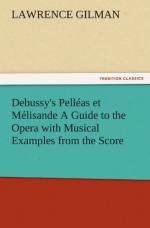It tempts one to extravagant praise, this heart-shaking and lovely drama; this vieille et triste legende de la foret, with its indescribable glamour, its affecting sincerity, its restraint, its exquisite and unflagging simplicity. The hesitant and melancholy personages who invest its scenes—Melisande, timid, naive, child-like, wistful, mercurial, infinitely pathetic; Pelleas, dream-filled, ardent, yet honorable in his passion; old Arkel, wise, gentle, and resigned; the tragic and brooding figure of Golaud; Little Yniold, artless and pitiful, a figure impossible anywhere save in Maeterlinck; the grave and simple diction, at times direct and homely in phrasing and imagery, at times rapturous, subtle, and evasive; the haunting mise-en-scene: the dim forest, the fountain in the park, the luminous and fragrant nightfall, the occasional glimpses, sombre and threatening, of the sea, the silent and gloomy castle,—all these unite to form a dramatic and poetic and pictorial ensemble which completely fascinates and enchains the mind. The result would have been as inconceivable before Maeterlinck undertook the writing of drama as, to-day, it is inimitable and untouched.
ITS ACTION
Maeterlinck’s play, as adapted by Debussy for musical setting, becomes a “lyric drama in five acts and twelve tableaux.” Certain portions have been left out—as the scenes, at the beginning of Act I and Act V, in which the servingwomen of the castle appear; the fourth scene of Act II, in which Pelleas is persuaded by Arkel to postpone his journey to the bedside of his dying friend Marcellus; the opening scene of Act III, between Pelleas, Melisande, and Yniold. Numerous passages that are either not essential to the development of the action, or that do not invite musical transmutation, have been curtailed or omitted, with the result that the movement of the drama has been compressed and accelerated throughout. In outlining very briefly the action of the play (which should be read in the original by all who would know Debussy’s setting of it) I shall adhere to the slightly altered version which forms the actual text of the opera.
The characters are these:
ARKEL, King of Allemonde
PELLEAS & GOLAUD, half-brothers, grandsons of
ARKEL
MELISANDE, an unknown princess; later the bride
of GOLAUD
LITTLE YNIOLD, Son of GOLAUD by a former
marriage
GENEVIEVE, Mother of PELLEAS and GOLAUD
A PHYSICIAN
Servants, Beggars, etc.




